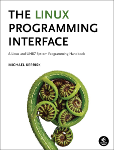|
HTML rendering created 2025-09-06 by Michael Kerrisk, author of The Linux Programming Interface. For details of in-depth Linux/UNIX system programming training courses that I teach, look here. Hosting by jambit GmbH. |

|
|
Name | Synopsis | Description | Files | Examples | Authors | See also | COLOPHON |
|
|
|
groff_trace(7) Miscellaneous Information Manual groff_trace(7)
groff_trace - macros for debugging GNU roff documents
groff -m trace [option ...] [file ...]
trace is a macro package for the groff(7) document formatting
system, designed as an aid for debugging documents written in its
language. It issues a message to the standard error stream upon
entry to and exit from each macro call. This can ease the process
of isolating errors in macro definitions.
Activate the package by specifying the command-line option
“-m trace” to the formatter program (often groff(1)). You can
achieve finer control by including the macro file within the
document; invoke the mso request, as in “.mso trace.tmac”. Only
macros that are defined after this invocation are traced. If the
trace-full register is set to a true value, as with the command-
line option “-r trace-full=1”, register and string assignments,
along with some other requests, are traced also. If another macro
package should be traced as well, specify it after “-m trace” on
the command line.
The macro file trace.tmac is unusual because it does not contain
any macros to be called by a user. Instead, groff's macro
definition and alteration facilities are wrapped such that they
display diagnostic messages.
Limitations
Because trace.tmac wraps the de request (and its cousins), macro
arguments are expanded one level more. This causes problems if an
argument uses four or more backslashes to delay interpretation of
an escape sequence. For example, the macro call
.foo \\\\n[bar]
normally passes “\\n[bar]” to macro “foo”, but with de redefined,
it passes “\n[bar]” instead.
The solution to this problem is to use groff's \E escape sequence,
an escape character that is not interpreted in copy mode.
.foo \En[bar]
/usr/local/share/groff/1.23.0/tmac/trace.tmac
implements the package.
We will illustrate trace.tmac using the shell's “here document”
feature to supply groff with a document on the standard input
stream. Since we are interested only in diagnostic messages
appearing on the standard error stream, we discard the formatted
output by redirecting the standard output stream to /dev/null.
Observing nested macro calls
Macro calls can be nested, even with themselves. Tracing recurses
along with them; this feature can help to detangle complex call
stacks.
$ cat <<EOF | groff -m trace > /dev/null
.de countdown
. nop \\$1
. nr count (\\$1 - 1)
. if \\n[count] .countdown \\n[count]
..
.countdown 3
blastoff
EOF
*** .de countdown
*** de trace enter: .countdown "3"
*** de trace enter: .countdown "2"
*** de trace enter: .countdown "1"
*** trace exit: .countdown "1"
*** trace exit: .countdown "2"
*** trace exit: .countdown "3"
Tracing with the mso request
Now let us activate tracing within the document, not with a
command-line option. We might do so when employing a macro
package like ms or mom, to avoid distraction by traces of macros
we didn't write.
$ cat <<EOF | groff -ms > /dev/null
.LP
This is my introductory paragraph.
.mso trace.tmac
.de Mymac
..
.Mymac
.PP
Let us review the existing literature.
EOF
*** .de Mymac
*** de trace enter: .Mymac
*** trace exit: .Mymac
As tracing was not yet active when the macros “LP” and “PP” were
defined (by s.tmac), their calls were not traced; contrast with
the macro “Mymac”.
trace.tmac was written by James Clark. This document was written
by Bernd Warken ⟨groff-bernd.warken-72@web.de⟩ and G. Branden
Robinson ⟨g.branden.robinson@gmail.com⟩.
Groff: The GNU Implementation of troff, by Trent A. Fisher and
Werner Lemberg, is the primary groff manual. You can browse it
interactively with “info groff”.
groff(1)
gives an overview of the groff document formatting system.
troff(1)
supplies details of the -m command-line option.
groff_tmac(5)
offers a survey of groff macro packages.
groff(7)
is a reference manual for the groff language.
This page is part of the groff (GNU troff) project. Information
about the project can be found at
⟨http://www.gnu.org/software/groff/⟩. If you have a bug report for
this manual page, see ⟨http://www.gnu.org/software/groff/⟩. This
page was obtained from the project's upstream Git repository
⟨https://git.savannah.gnu.org/git/groff.git⟩ on 2025-08-11. (At
that time, the date of the most recent commit that was found in
the repository was 2025-08-09.) If you discover any rendering
problems in this HTML version of the page, or you believe there is
a better or more up-to-date source for the page, or you have
corrections or improvements to the information in this COLOPHON
(which is not part of the original manual page), send a mail to
man-pages@man7.org
groff 1.23.0.3821-a8b3f 2025-08-09 groff_trace(7)